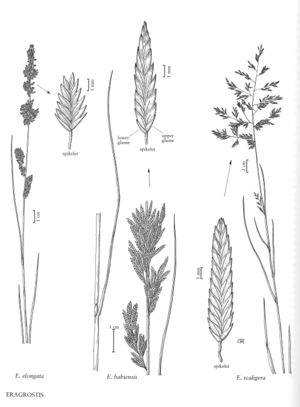Difference between revisions of "Eragrostis bahiensis"
FNA>Volume Importer |
imported>Volume Importer |
||
| (8 intermediate revisions by 2 users not shown) | |||
| Line 17: | Line 17: | ||
-->{{Treatment/Body | -->{{Treatment/Body | ||
|distribution=N.J.;La.;Ala.;Ga.;S.C.;Fla. | |distribution=N.J.;La.;Ala.;Ga.;S.C.;Fla. | ||
| − | |discussion=<p>Eragrostis bahiensis grows in sandy soils near river banks, lake shores, and roadsides, at 0-200 m. Its range extends south from the Gulf Coast of the United States through Mexico to Peru, Bolivia, Paraguay, and Argentina.</p> | + | |discussion=<p><i>Eragrostis bahiensis</i> grows in sandy soils near river banks, lake shores, and roadsides, at 0-200 m. Its range extends south from the Gulf Coast of the United States through Mexico to Peru, Bolivia, Paraguay, and Argentina.</p> |
|tables= | |tables= | ||
|references= | |references= | ||
| Line 26: | Line 26: | ||
-->{{#Taxon: | -->{{#Taxon: | ||
name=Eragrostis bahiensis | name=Eragrostis bahiensis | ||
| − | |||
|authority=(Schrad.) Schult. | |authority=(Schrad.) Schult. | ||
|rank=species | |rank=species | ||
| Line 33: | Line 32: | ||
|basionyms= | |basionyms= | ||
|family=Poaceae | |family=Poaceae | ||
| + | |illustrator=Linda A. Vorobik;Cindy Roché | ||
| + | |illustration copyright=Utah State University | ||
|distribution=N.J.;La.;Ala.;Ga.;S.C.;Fla. | |distribution=N.J.;La.;Ala.;Ga.;S.C.;Fla. | ||
|reference=None | |reference=None | ||
| Line 38: | Line 39: | ||
|publication year= | |publication year= | ||
|special status= | |special status= | ||
| − | |source xml=https:// | + | |source xml=https://bitbucket.org/aafc-mbb/fna-data-curation/src/200273ad09963decb8fc72550212de541d86569d/coarse_grained_fna_xml/V25/V25_162.xml |
|subfamily=Poaceae subfam. Chloridoideae | |subfamily=Poaceae subfam. Chloridoideae | ||
|tribe=Poaceae tribe Cynodonteae | |tribe=Poaceae tribe Cynodonteae | ||
Latest revision as of 18:57, 11 May 2021
Plants perennial; cespitose, with innovations, without rhizomes, not glandular. Culms 25-95(110) cm, erect, glabrous. Sheaths glabrous, summits hairy, hairs 1-3 mm; ligules 0.2-0.4 mm; blades (8)12-40 cm long, 2-5 mm wide, flat to involute, abaxial surfaces glabrous, adaxial surfaces scabridulous and glabrous or long ciliate basally. Panicles terminal, 15-30(45) cm long, (4)8-17 cm wide, narrowly ovate, open to contracted; primary branches 5-15 cm, diverging 20-90° from the rachises, often capillary, usually naked basally; pulvini glabrous; pedicels 0.3-6 mm, mostly appressed, scabridulous, always shorter than the spikelets. Spikelets 6-15(18) mm long, 1.3-2(2.2) mm wide, narrowly lanceolate, plumbeous, occasionally with a reddish-purple tinge, with 8-30(40) florets; disarticulation usually in the rachilla below the florets, occasionally the lemmas falling separately, leaving the paleas on the rachilla. Glumes lanceolate to ovate, membranous to subhyaline, keeled; lower glumes 1-1.4 mm; upper glumes 1.4-1.7 mm; lemmas 1.5-2.2 mm, broadly ovate, leathery, scabridulous, lateral veins evident, apices acute; paleas 1.4-2.1 mm, hyaline, bases not projecting beyond the lemmas, keels scabridulous, apices acute to obtuse; anthers 2, 0.4-0.6 mm, reddish-purple. Caryopses 0.6-0.8 mm, obovoid to ellipsoid, terete, somewhat striate, reddish-brown. 2n = unknown.
Distribution
N.J., La., Ala., Ga., S.C., Fla.
Discussion
Eragrostis bahiensis grows in sandy soils near river banks, lake shores, and roadsides, at 0-200 m. Its range extends south from the Gulf Coast of the United States through Mexico to Peru, Bolivia, Paraguay, and Argentina.
Selected References
None.
